Elevate Your Bedroom Decor with Stylish Curtains


Intro
Curtains play a vital role in shaping the ambiance of a bedroom. Choosing the right curtains can make a marked difference in how a space feels. It’s not just about blocking light; it's about expressing personal style and adding character to your sanctuary. This article aims to guide you through the myriad options available, ensuring you make informed choices that mesh seamlessly with your decor.
The goal is to elevate your bedroom aesthetics through the careful selection of styles, materials, and color palettes. Everyone has a unique vision for their personal space, and by understanding the nuances of curtain choices, you can transform your bedroom into a haven that reflects your taste.
Understanding the art of selecting curtains involves more than just grabbing a random set off the shelf. It is a blend of functionality and design. Whether your preference leans toward classic, modern, or bohemian styles, the right curtains can weave together the elements of your space.
Now, let’s dive into the specifics, starting with the inspiration behind curtain design. We will unravel the trends that are currently capturing the hearts of homeowners, as well as the practical considerations to keep in mind.
Understanding the Impact of Curtains in Bedroom Design
When it comes to crafting a bedroom that truly resonates with personal style, the role of curtains can hardly be overstated. Curtains are not just functional; they serve as a significant design element that enhances the overall aesthetic. This section explores various aspects of the impact curtains have in bedroom design, delving into how they influence ambiance, space perception, and functionality.
The Role of Curtains in Defining Space
Curtains can create a clear boundary in a room, marking where one area ends and another begins. For instance, if your bedroom includes a small sitting area or alcove, using curtains to separate it from the rest of the room can offer a sense of privacy, making the space feel more intimate. By doing so, you can transform a simple bedroom into a multifunctional retreat.
In homes with open floor plans, curtains can be especially handy. They give the illusion of defined spaces without the need for walls. Hung from the ceiling with a light touch, they can sway gently, adding movement to the room without overwhelming it. Choosing the right length and fabric can either make the ceiling seem higher or create warmth, allowing for a sense of comfort.
Impact on Natural Light and Privacy
Curtains play a dual role when it comes to light and privacy regulation. On one hand, they can control the amount of natural light that enters the room. For example, lightweight sheer curtains allow gentle sunlight to filter through while preserving a degree of visibility, making a room bright and airy.
On the flip side, thicker fabric curtains serve as a barrier against intrusive sights and sounds. Imagine waking up in the morning; you might prefer to draw the heavy drapes closed, blocking out the noise of the bustling street below, converting your bedroom into a serene sanctuary.
"The balance between natural light and privacy can transform how you experience your bedroom, influencing mood and comfort."
In summary, curtains are vital in dictating how light and sound interact within the space, shaping your daily experiences and contributing to a desirable atmosphere in your sleeping quarters. Through thoughtful selection of fabric and style, you can manipulate the lightness and dimension of your bedroom, allowing it to evolve from a standard sleeping area into a soothing retreat.
Styles of Curtains for Bedroom Decor
When it comes to bedroom decor, the style of curtains you choose can set the stage for the entire space. Curtains play a significant role not just in aesthetics but also in functionality, influencing both the atmosphere and ambiance of a room. The right style can harmonize with your existing decor, enhance natural light flow, and provide the desired level of privacy. Ultimately, selecting the right curtain style speaks volumes about your personal taste and creates a cozy haven for relaxation.
Traditional Curtain Styles
Traditional curtain styles often evoke a sense of elegance and timelessness. These options typically include classics such as pleated drapes, valances, and lace curtains.
- Pleated Drapes: These feature evenly spaced folds, offering a tailored look that works well in formal settings. They can add an air of sophistication to your room, particularly when made from heavier fabrics that drape beautifully.
- Valances: Often used as a top treatment, valances can act as a design statement. They frame the window and can be paired with longer curtains for a layered effect.
- Lace Curtains: Ideal for achieving a light and airy feel, lace curtains diffuse harsh sunlight while still allowing a glimpse of the outside world. They twist nostalgia with a touch of femininity, perfect for evoking a calm, serene environment.
Choosing a traditional style can also influence the mood of the bedroom. Rich, deep colors can create warmth, while softer shades can lend a light, tranquil atmosphere.
Modern and Minimalist Options
For those who appreciate clean lines and uncluttered spaces, modern and minimalist curtain styles are ideal. This approach emphasizes simplicity and functional design, reducing visual clutter.
- Curtains with Grommets: Minimalist designs often feature grommets, which allow for smooth movement along the rod. This provides a flat, elegant look that fits seamlessly into sleek, contemporary decor.
- Sheer Panels: Thin, sheer curtains can create an open, airy vibe while still leading in natural light. They enrich the space subtly without overwhelming it.
- Neutral Tones: Opting for shades such as whites, greys, or beiges can harmonize beautifully with a modern aesthetic. It allows the eye to flow freely around the room without distraction.
Such styles not only embrace functionality but also create a peaceful refuge of minimalism.
Bohemian and Eclectic Choices
If you lean toward a free-spirited aesthetic, bohemian and eclectic curtain styles may resonate with you. This approach embodies a mix-and-match philosophy that embraces individuality and creativity.
- Layered Fabrics: Combine various textures, colors, and patterns to create a unique visual experience. Fabrics like cotton, burlap, and lace can coexist in a delightfully mismatched arrangement.
- Bold Patterns: Look for curtains with vibrant prints, such as florals or geometric shapes. These can act as a focal point in your decor, adding life and character to your space.
- Cultural Textile: Incorporate fabrics from around the world to reflect your travels or heritage. This can result in a conversation starter, triggering memories while dressing up your space.
This style allows you the freedom to express who you are, making your bedroom a true reflection of your personality. With the right curtain styles, the journey of designing your bedroom can be not just a task but an intimate experience that brings your vision to life.
Material Matters: Selecting the Right Fabric
When it comes to bedroom decor, the material of your curtains can make or break the look and feel of the space. Choosing the right fabric goes beyond aesthetics; it also affects functionality, durability, and comfort in your room. The right fabric not only enhances the overall design but also provides practical benefits like light control, insulation, and ease of maintenance. Let's dive into the main fabric categories and what each brings to the table.
Cotton vs. Linen: A Comparative Analysis
Cotton and linen are commonly favored fabrics for curtains, but they each offer distinct characteristics. Cotton is celebrated for its versatility and affordability. It comes in a range of colors, patterns, and weights, making it a practical choice for various decor styles. Its ease of cleaning is a significant advantage, especially in homes with children or pets.
Linen, on the other hand, exudes an air of sophistication. It has a natural, textured look that adds depth to a room. However, it tends to wrinkle easily, which may not sit well with some homeowners looking for low-maintenance options.
- Durability: Linen is generally more durable but can be sensitive to prolonged sunlight. Cotton is tough but may fade over time depending on the quality.
- Feel: Cotton is soft and user-friendly while linen provides a crisp, classic touch that feels almost luxurious.
Deciding between cotton and linen ultimately comes down to your lifestyle and design vision. If you want a casual, easy-going vibe, cotton is your go-to. If elegance and texture are at the top of your list, linen could be worth the splurge.
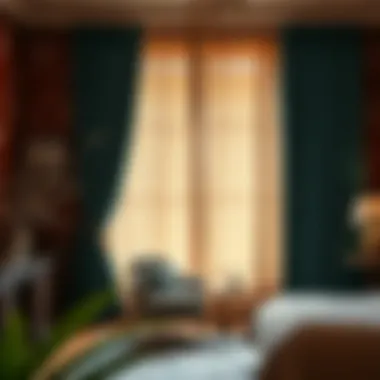
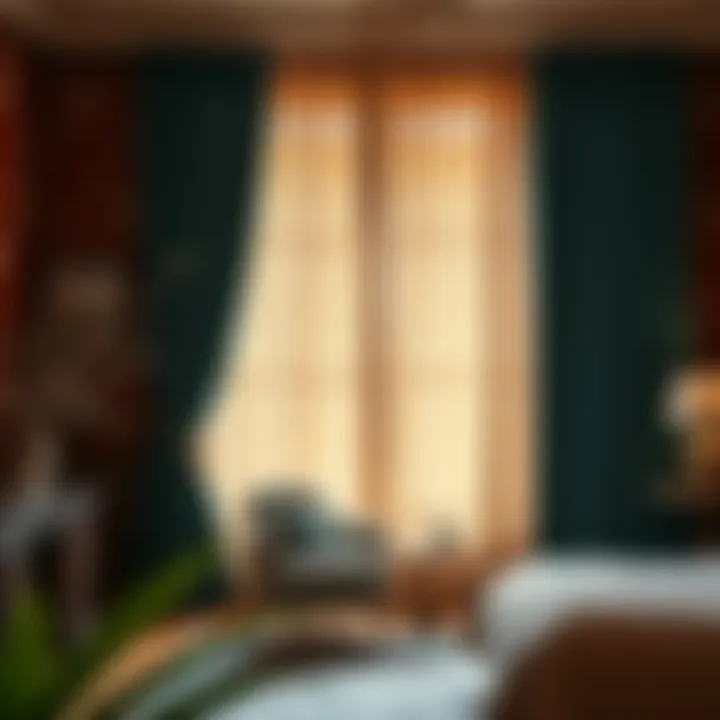
Silk and Velvet: Luxurious Options
If you are aiming for a high-end look, silk and velvet are the fabrics to consider. Silk curtains give a rich luster that brightens any room, combining beauty and functionality. They are fantastic at blocking out light and come in an array of colors and patterns. However, silk requires careful maintenance; it’s best to dry clean to preserve its sheen and quality.
Velvet, with its plush texture, brings warmth and comfort to the bedroom. This fabric can absorb sound well, making your sanctuary quieter. Velvet is also versatile, being both chic and contemporary.
- Considerations: Both materials come with a price tag that reflects their luxury. If you invest in silk or velvet, think about the long-term maintenance and potential faded color from sunlight.
For those who want to add opulence to their bedroom, a silk or velvet curtain can serve as the centerpiece of the decor.
Synthetic Fabrics: Pros and Cons
Synthetic fabrics such as polyester and nylon are increasingly popular in curtain design due to their resilience and affordability. They’re often designed to mimic natural fibers but can come with their own set of pros and cons.
- Pros: Synthetic curtains are generally easy to clean, quick to dry, and often resistant to fading, making them a handy option for busy lifestyles. They can come in numerous styles and colors, fitting into any modern home.
- Cons: On the flip side, synthetic fabrics may not breathe as well as natural fibers, which can lead to a stuffy feeling in the bedroom. The feel of synthetic options can also lack the rich texture that a natural fabric provides.
In essence, while synthetic fabrics offer convenience and practicality, they may fall short for those seeking an authentic, natural feel in their bedroom decor.
"Choosing the right fabric for your curtains is not just about aesthetics; it directly shapes the atmosphere, comfort, and functionality of your space."
In summary, selecting the right fabric is crucial in enhancing the bedroom's ambiance. Whether you lean toward natural materials like cotton or linen, indulge in the luxury of silk or velvet, or opt for the practicality of synthetics, understanding the qualities of each will guide you to curtains that not only look stunning but also serve your unique needs.
Color Theory in Curtain Selection
When it comes to designing a bedroom, the choice of curtain color is a paramount consideration. Colors conjure emotions, set moods, and can make or break the aesthetic of a space. Understanding color theory in the context of curtain selection is not just an art; it’s a crucial part of elevating your room’s decor to new heights.
Using color effectively allows one to create harmony and balance within the room. Imagine stepping into a bedroom where the walls are painted a soothing pastel blue and the curtains are a bright, clashing orange. The result can feel chaotic rather than serene. On the flip side, a light gray curtain draped gracefully over a soft beige wall can make everything come together seamlessly. Hence, it’s vital to consider how the colors of your curtains play off the existing hues of your walls and furnishings.
There are also psychological aspects behind colors. For instance, blues and greens can evoke feelings of calmness and tranquility, making them excellent choices for bedrooms where relaxation is key. In contrast, reds and bright yellows can create energy and vibrancy, but in a bedroom setting, they might be too stimulating.
Harmonizing Colors with Bedroom Decor
When trying to harmonize curtain colors with bedroom decor, understanding the color wheel is essential. To achieve a cohesive look, consider the following:
- Analogous colors (colors next to each other on the color wheel) can give a soothing effect. For instance, pairing a soft lavender curtain with pale pink and white wall decor can result in a tranquil atmosphere.
- Complementary colors (colors opposite each other on the wheel) create contrast. A deep emerald green curtain against a warm, sandy beige wall can help to create a focal point in the room.
- Monochromatic schemes involve using varying shades of the same color. Light and dark shades of gray curtains can add depth while ensuring the room feels unified and intentional.
Prices and quality can vary, so taking time to sample fabric swatches in the intended room’s lighting is wise. This allows you to see how colors interact with the space at different times of the day.
Using Curtains to Create Focal Points
Curtains not only serve a practical purpose but can also enhance the visual interest of a room. Utilizing colors to create focal points can draw attention where it’s needed, adding character to the decor.
- Bright and Bold: If your bedroom has several neutral elements, consider using curtains in a bold color or pattern. A bright floral design against white walls can breathe life into the space and can be particularly effective in making a statement.
- Cut and Flow: Furthermore, the way curtains fall can accentuate particular areas. For instance, floor-length curtains can elongate the room, especially when paired with a high curtain rod. This verticality draws the eye upwards, adding a sense of spaciousness.
- Layering Colors: Layering curtains—combining sheers with heavier fabrics—also gives depth and intrigue. The sheer layer can be a delicate pastel, letting in diffused light, while a heavier outer curtain can incorporate bolder colors to match the bedroom's style.
Ultimately, the role of color in curtain selection goes beyond mere aesthetics. It’s intricately tied to the feeling you want to evoke in the space. Taking these considerations to heart will ensure that your curtain choice contributes positively to your bedroom decor.
Functional Considerations for Bedroom Curtains
When it comes to bedroom decor, curtains aren’t merely decorative pieces; they serve essential functions that can significantly enhance the comfort and atmosphere of the space. Understanding the functional aspects of curtains can lead to more informed choices that result in a well-rounded aesthetic. Whether you're aiming for a cozy retreat or a sophisticated setting, these functional considerations will guide your curtain selections to better meet your needs.
Thermal and Insulating Properties
One of the paramount benefits of curtains is their ability to block out heat and cold, acting as barriers against temperature fluctuations. Curtains made from heavier materials such as velvet or specially designed thermal fabrics can keep your bedroom warm in winter and cool during summer. This insulation is crucial for maintaining a comfortable environment without relying excessively on heating or cooling systems, which can be a wallet drainer.
When choosing curtains for thermal efficiency, consider:
- Weight of the Fabric: Heavier fabrics generally provide better insulation. Look for options that are lined or specifically marketed as thermal.
- Full Coverage: Ensure curtains are wide enough to cover the window fully, preventing heat escape around gaps.
- Length Matters: Longer curtains that reach the floor not only look elegant but also trap air, enhancing insulation.
"Curtains do more than adorn windows; they are guardians against the elements, turning your sanctuary into a climate-controlled haven."
Consider investing in quality curtains that promise thermal insulation, as the upfront cost can save you on energy bills in the long run. Custom-made options are also available, enabling you to maximize coverage and fit.
Sound Absorption and Privacy Features
Curtains are often underestimated when it comes to their sound-dampening capabilities. Thick, layered curtains can absorb sound, creating a more serene environment, especially beneficial for those living in bustling urban settings or near busy roads. The right curtains can make your space feel like a calm oasis amidst the noise of the outside world.
When selecting curtains for sound absorption, keep these points in mind:
- Material Choice: Fabrics like heavy cotton, polyester blends, or wool are better at reducing noise. Look for tightly woven textures that absorb rather than transmit sound.
- These Extras Help: Adding a blackout or thermal lining can further enhance soundproofing qualities.
Privacy is another cornerstone of bedroom comfort. Strategically chosen curtains can shield your personal space from prying eyes. For optimal privacy without sacrificing natural light, consider:
- Light Filtering Fabrics: Combinations of sheer curtains layered under thicker, opaque curtains can give you the best of both worlds.
- Layering Techniques: Create depth and privacy with various layers, using sheers during the day for light and thick curtains at night for complete seclusion.
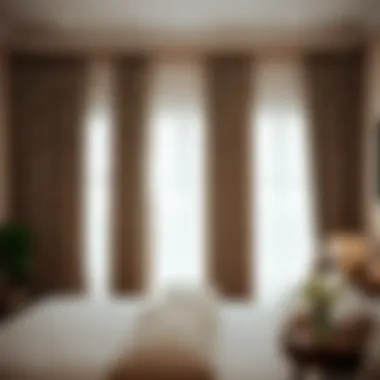
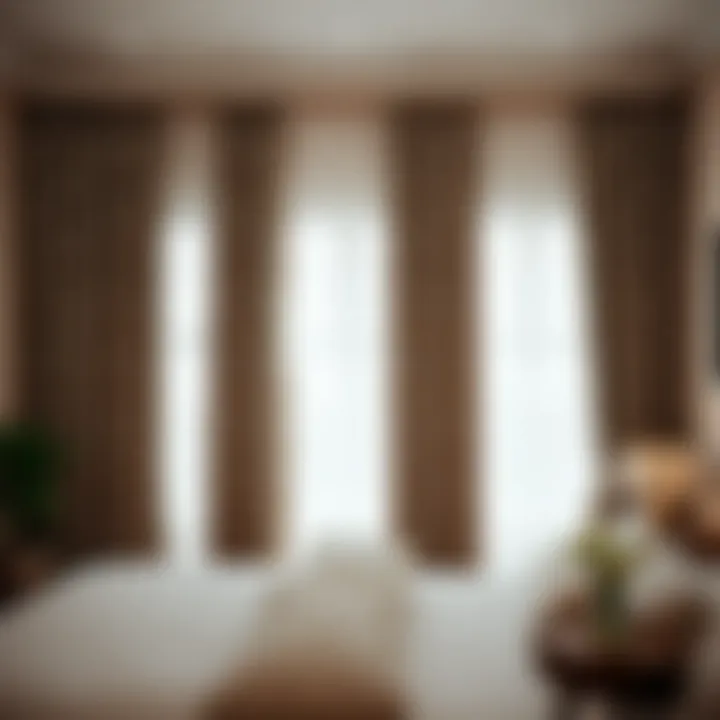
In summary, incorporating functional elements into your curtain choices greatly enhances their practicality beyond aesthetics. Whether your bedroom needs temperature regulation or sound reduction, understanding these functional considerations helps create a living space that’s not only beautiful but also conducive to relaxation and serenity.
Hanging Curtains: Techniques and Tips
Hanging curtains might seem straightforward, but there’s an art to it that can greatly impact not just the aesthetics, but the functionality of your space. Choosing the right method and materials is crucial to achieving that polished look and feeling. From the intricate details of measurements to the various styles of curtain rods available, getting these aspects right will enhance the overall decor of your bedroom.
Measuring for Perfect Fit
The cornerstone of any successful curtain hanging starts with accurate measurements. A curtain can be the pièce de résistance of a room, but ill-fitted drapes can mar its elegance. Here's how you go about it:
- Determine Your Rod Height: Generally, curtains should be hung high, close to the ceiling, to create an illusion of taller walls. Measure from your intended rod placement down to the floor.
- Width Matters: For a fuller look, a good rule of thumb is to multiply your window width by 1.5 to 3 times. This will allow your curtains to gracefully pool or drape nicely when closed.
- Consider Your Style: Depending on whether you’re all about that bohemian vibe or a more modern aesthetic, the length can vary. Decide if you want floor-length curtains, which tend to create drama, or ones that lightly touch the sill.
Any small miscalculations can lead to frustrating results. As they say, "measure twice, cut once," and in this case, measure twice, hang once.
Hanging Methods: Rods vs. Tracks
When it comes to hanging curtains, the choice between rods and tracks can affect not only the visual appeal, but also functionality:
- Curtain Rods: These are often the more popular choice since they offer a traditional look and are relatively easy to install. Curtain rods come in various materials—wood, metal, and even plastic—each adding its own character.
- Tracks: If you're leaning toward a more modern approach or using heavier fabrics, tracks might be the way to go. They can support more weight and facilitate smoother movement of the curtains. Tracks can also be mounted inside the recess of the window for a clean, streamlined appearance.
There's also a matter of personal preference here; while some people swear by the charm of rods with finials, others prefer the minimalism of tracks. It really ties back to the vibe you’re aiming for—cozy comfort or sleek simplicity.
"The curtains may be just fabric, but they can transform a dull room into a captivating retreat."
Whichever method you choose, getting the installation right will pay dividends in the long run. No one likes a curtain that refuses to slide or a rod that bows under the weight of fabric. Taking the time to make these selections thoughtfully means you are investing in years of bedroom beauty and comfort.
Layering Curtains for Depth and Texture
Layering curtains can transform a bedroom from mundane to magnificent, injecting unparalleled depth and texture into the atmosphere. This technique is not merely about adding more fabric to a window; it’s about creating a visual landscape that reflects personality and function. The strategic combination of different curtain styles can invigorate a space with warmth, sophistication, and dynamic visual interest.
Combining Sheers and Blackouts
One of the most effective combinations is the pairing of sheer curtains with blackout drapes. Sheer curtains allow soft, diffused light to filter into the room, creating a gentle ambiance that can soothe the senses. They are especially desirable for their lightness and airy feel, capturing a romantic essence that can elevate any decor style.
However, sheer alone can sometimes offer limited privacy, and that's where blackout curtains play their part. They provide the necessary opacity for darker hours, enhancing sleep quality by blocking out the sun's rays completely. Combining these two types of curtains not only ensures comfort and functionality but also adds a layered look which makes the room feel more inviting.
"Layering isn’t just about looks; it’s about experience. The interplay of light and shadow can alter the mood of your retreat."
In practice, one can hang the sheer curtains closest to the window frame for an ethereal effect while using the blackout curtains on a separate rod, positioned slightly away from the window. This creates a “floating” effect, adding depth and dimension that can turn a simple bedroom into a cozy haven.
Accessorizing with Valances and Drapes
Accessorizing with valances can also significantly enhance layered curtains. Valances are short, decorative treatments that cover the top part of the window and add a finished look. They can frame the window beautifully and provide an extra layer of visual interest without obstructing light. When paired with longer drapes, they create a tiered effect that can give the illusion of higher ceilings and oversized windows. For instance, using a patterned fabric for the valance can bring out the subtler tones in the drapes, pulling everything together.
Drapes with a heavier material, like velvet, add not just texture but also a sense of luxury. By mixing fabrics with different weights and textures, like a flowy sheer with a hefty velvet, you can achieve a look that feels rich and complex. This contrast is essential in maintaining a lively space while ensuring it is well-coordinated.
Utilizing decorative elements such as tiebacks or curtain holdbacks can also contribute to the playful layering of curtains. These accessories allow you to pull back drapes neatly, revealing the sheer curtains behind and letting in more light without losing the stylish layering. Ultimately, it's about finding that sweet spot where function meets elegance, creating a harmonious environment tailored to your personal style.
Incorporating these layering techniques not only enhances aesthetics but also improves the functionality of your space. Whether you want a soft glow of morning light or complete darkness for sleep, mastering the art of layering curtains opens up a world of design possibilities.
Trends in Bedroom Curtain Design
Curtains have evolved far beyond their basic utilitarian purpose. In contemporary bedroom decor, they serve not only as functional pieces that manage light and privacy but also as pivotal elements that can tie together the aesthetic of your sanctuary. Recognizing trends in bedroom curtain design can help homeowners and design enthusiasts alike craft spaces that are both stylish and comfortable. Current trends reflect a deeper understanding of sustainability, technology, and color interplay that resonates with today’s values and lifestyles.
Sustainability in Curtain Choices
As we become increasingly aware of environmental issues, sustainability in curtain choices has taken center stage. Consumers are now looking for more than just attractive fabric; they want eco-friendly materials that contribute to a healthier planet.
When considering sustainable options, think about:
- Natural Fibers: Fabrics like organic cotton, hemp, and bamboo not only have a lower environmental impact but are also often more breathable and durable.
- Recycled Materials: Curtains made from recycled polyester reduce waste and can be just as stylish as new fabrics.
- Local Production: Supporting local artisans and manufacturers reduces carbon footprints associated with shipping and promotes regional economies.
The importance of sustainability goes beyond mere decoration; it’s about aligning personal style with a commitment to responsible living.
"Sustainable choices in home decor signal a change in the way we value our spaces and the environment we live in."
Smart Curtains: A Modern Innovation
Technology has seeped into every facet of our lives, and window treatment is no exception. Smart curtains are gaining traction, merging functionality with convenience. These innovative designs allow homeowners to control natural light and privacy at the touch of a button—or even through voice commands.
Key elements of smart curtain technology include:
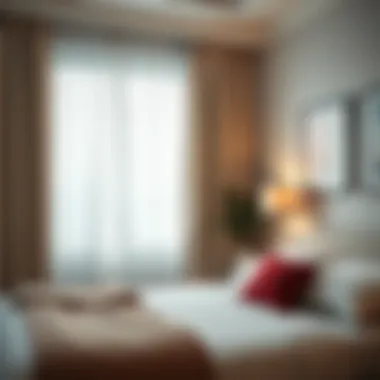
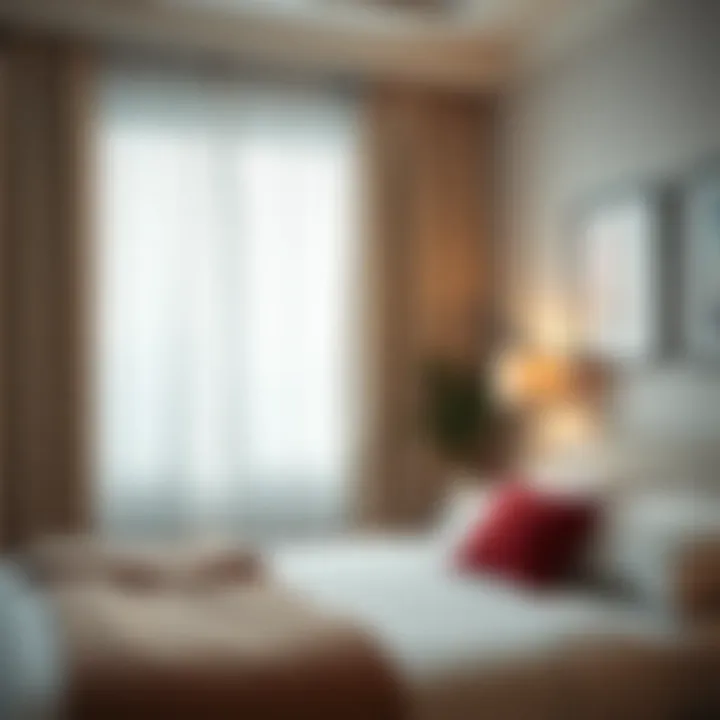
- Motorization: Many modern curtains offer motorized systems that can be programmed to open or close at specific times, optimizing energy use and enhancing security.
- Integration with Smart Home Systems: Curtains can now seamlessly integrate with popular smart home systems like Google Home or Amazon Alexa, allowing users to control their environment through voice commands or mobile apps.
- Light Sensors: Advanced models even come equipped with sensors that adjust automatically based on the time of day or the brightness of sunlight.
Investing in smart curtains does more than elevate convenience. It enhances energy efficiency, contributing to lower utility bills while keeping your living spaces comfortable.
In summary, the trends in bedroom curtain design show a clear shift towards sustainability and technological integration. As homeowners prioritize their individual style along with eco-conscious choices, curtains serve as a unique intersection of functionality, design, and lifestyle. Keeping an eye on these trends allows for the creation of a space that is modern, comfortable, and in tune with the world around us.
Maintenance and Care for Bedroom Curtains
Caring for your bedroom curtains is crucial, not just for their aesthetic appeal, but also for their longevity and functionality. Curtains are often exposed to dust, sunlight, and various pollutants, which can accumulate over time and lead to fading or deterioration. By implementing a regular maintenance routine, you ensure that these additions to your decor remain vibrant and effective in their roles.
Cleaning Techniques Based on Fabric Type
Each type of curtain fabric requires a unique cleaning approach. Here’s a breakdown of common materials and how to maintain them:
- Cotton: Easy to maintain. Machine wash on a gentle cycle in cold water with mild detergent. For stubborn stains, pre-treat with a fabric-safe stain remover. Hang to dry to avoid shrinkage.
- Linen: Delicate and breathable. Hand wash in cool water or use a gentle cycle; air dry to preserve their texture. If wrinkles appear, a warm iron can help smooth them out after they’ve dried completely.
- Silk: High maintenance but luxurious. Use a damp cloth to gently spot-clean or take them to a dry cleaner for professional care. Avoid soaking or machine washing, as it may damage the fibers.
- Synthetic Fabrics (like polyester): Generally resistant to wrinkles and fading. Machine wash on a gentle cycle with cool water. You can tumble dry on low heat, but it's often best to hang dry to maintain shape and structure.
It’s essential to check care labels before undertaking any cleaning procedures, as they can provide specific instructions that might vary from these general guidelines.
Preservation Tips for Longevity
To extend the life of your curtains, consider the following tips:
- Rotate Them: If you have multiple sets of curtains, rotating them can help prevent excessive fading from the sun. This is a simple way to maintain color integrity.
- Use Lining: Adding a lining not only enhances the aesthetic appeal but also protects the fabric from direct sunlight and heat, which can cause discoloration over time.
- Regular Dusting: Incorporate a light dusting routine using a soft cloth or vacuum with an upholstery attachment to minimize dust build-up. Consider doing this once a month.
- Avoid Dampness: Be cautious about moisture in the room. Excess humidity can lead to mold or mildew, which can compromise both the fabric and any hardware.
- Follow Manufacturer's Instructions: Always adhere to specific cleaning and care recommendations provided by the manufacturer to avoid voiding warranties and causing unintended damage.
Maintaining your curtains not only helps them look good but also keeps your whole bedroom atmosphere fresh and welcoming.
Through these techniques and tips, you'll not only ensure your curtains remain a focal point of your bedroom decor but also enjoy the comfort and aesthetic that well-maintained curtains bring to your space.
Curtains as a Reflection of Personal Style
When it comes to decorating the bedroom, curtains can be a personal statement, a blend of aesthetics, and a reflection of individuality. The choice of curtains goes beyond mere functionality; they possess the ability to define the atmosphere of the space and speak volumes about the taste of the homeowner. This section explores how curtains can encapsulate personal style, focusing on various aspects that one should consider.
Choosing Patterns that Speak to You
Selecting a pattern for your curtains is akin to picking a piece of art for your wall—it's an expression of your personality and mood. Patterns can carry meaning and evoke emotions, making them a crucial part of any bedroom's decor.
- Floral Patterns: These are timeless. They can bring the essence of nature indoors, adding a breath of freshness to the room.
- Geometric Designs: These create a modern edge, perfect for those who love a minimalist approach or contemporary vibes.
- Solid Colors: Sometimes, simplicity speaks the loudest. A solid shade can complement an already busy color scheme or stand out beautifully against muted decor.
When selecting patterns, it's also important to consider how they relate to the other elements in your bedroom. Will they clash with your bedspread or the art on your walls? Striking the right balance can contribute to a cohesive and harmonious environment.
Incorporating Cultural Textiles
Cultural textiles can bring a unique and global flavor to your bedroom. Many homeowners are tapping into their heritage or simply exploring new cultures through their curtain choices. Here are a few ways to integrate these elements:
- Batiks from Indonesia: These hand-dyed fabrics often come in bright, bold designs, which can create an eye-catching focal point.
- Ikat Patterns from Central Asia: Their intricate designs could serve as conversation starters and add layers of history to your decor.
- Woven Textiles from West Africa: Bright, vibrant patterns can transform an otherwise subdued space into a vivid celebration of artistry and culture.
By incorporating these textiles, you not only personalize your space but also pay homage to the craftsmanship and stories behind such designs. Yet, it’s vital to ensure that these pieces complement one another for a well-thought-out oragnization.
"Your curtains shouldn’t just hang there; they should tell your story."
Ultimately, the way you express yourself through curtains can significantly affect how you feel in your space. Personalization turns the ordinary into the extraordinary, making your bedroom not just a place to sleep, but a bastion of your identity.
Budgeting for Quality Curtains
When it comes to decorating a bedroom, curtains play a critical role. They not only add style but also influence how the space feels overall. However, the question often looms: how much should one spend on these essential pieces?
Understanding Price Ranges and Quality
Budgeting for quality curtains isn’t just about setting aside a certain amount of cash to grab the first option you see. It’s about understanding the landscape of prices and what those prices actually mean in terms of quality. Different materials and styles come with different price tags.
For example, a basic set of polyester curtains can start as low as $20, while luxurious silk options might climb into the hundreds. Don't let the shiny tags scare you off though; sometimes, those higher price points translate into better durability and design versatility. Investing wisely can save your wallet in the long run, as quality curtains may outlast their cheaper counterparts by several years.
Consider this when budgeting:
- Material: Natural fibers like silk and linen tend to be more expensive than synthetics.
- Brand and Designer: Name brands often come with a higher price tag but can offer unique designs that stand out.
- Customization: Custom-made curtains typically cost more, but they ensure a perfect fit for your windows.
Investing in Versatile Styles
A thrifty homeowner knows the value of versatility. When selecting curtains, think beyond just aesthetics. Choose styles that can transition seamlessly between seasons or occasions. For instance, lighter fabrics like sheer cotton can provide a breezy ambiance in warmer months and work well with heavier drapes during colder months.
By opting for neutral colors or patterns, you can frequently switch up the bedroom decor without breaking the bank. Here are some versatile styles to consider:
- Classic Solid Colors: Easy to match with almost any decor style.
- Patterns: Subtle floral or geometric patterns can add a playful touch while still being adaptable.
- Layerable Options: Like pairing sheers with blackout curtains; this allows you to manage light and privacy efficiently.
Investing in quality curtains is not merely a cost; it’s an investment in your comfort and overall aesthetic. Remember, a well-decorated space significantly impacts your mood and productivity. So, weigh the pros and cons, and go for curtains that promise to elevate rather than just fill a need.
"Quality over quantity applies here. A single stunning pair of curtains can do the job of multiple lesser sets."



